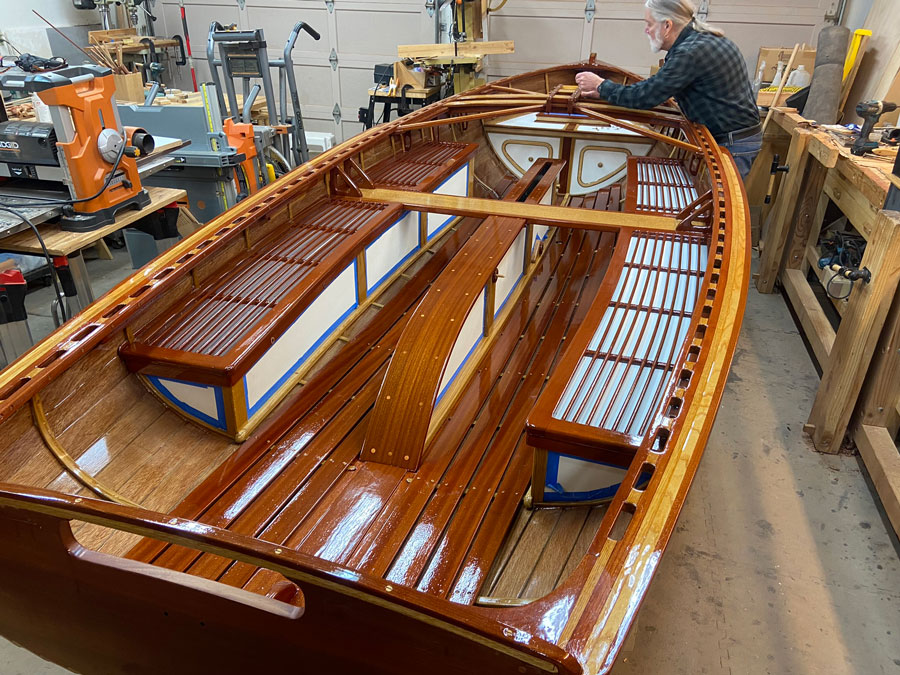Top Hat is a 15.5’ LOA x 5’ beam, maximum 2-person crew, racing dinghy modeled after the 1938 and 1946 Prince of Wales Cup-winning International 14 Class* (footnote) Thunder and Lighting, designed by Uffa Fox, the foremost and most innovative designer of 1930s era high-performance sailing dinghies.
Top Hat differs from its original inspiration, the Thunder and Lightning, and her sister International 14s of the same era in a number of respects to promote, greater seaworthiness and an easier and faster plane with a heavy crew having a total weight of up to 360 lbs.
In all other respects Top Hat’s design and construction strictly adhere to 1929 Original Class Rules governing minimum and maximum measurements for sail, mast, and hull structural components, and the prescribed minimum 225 lb. hull weight stripped of all gear, including sails, spars, rudder, centerboard and floor-boards (See footnote below.) A balanced lug rig, permitted under those same rules, has been experimentally substituted on the Top Hat for the sloop rig utilized by the 1938 Thunder and Lightning.
With her plumb stem and stern, flared gunwales forward, her gracefully curving sheer line descending gently to tumble-home aft and her completely open cockpit, the unballasted and non-trapeze Top Hat maintains the traditional look and sporty feel of 1930s International 14s that once raced in often brisk winds and choppy waters off the coast of Cowes on the English Channel.
Top Hat’s 6mm mahogany marine plywood glued lapstrake 12-plank-per-side hull is reinforced for further stiffness with steam-bent oak ribs (13.25” on center) and mahogany and oak stringers running fore-and-aft; these at all contact points are exclusively through-hull fastened with epoxy glued, white oak dowels.
Due to a unique, reversible mast partner component, Top Hat may be rigged either as a single sail 140 sq. ft. unstayed balanced lug or stayed sloop rig with jib and main totaling the same sail area. Top Hat’s, balanced-lug, tan-bark, triple reefing sail was made by Simple Sails in the Philippines in consultation with Michael Storer, that firm’s original founder and owner. Spars and oars are laminated Alaska Sitka Spruce.
The high-aspect, aerodynamic centerboard and rudder foils borrow loosely from the shapes and depths of Bruce Kirby designed International 14s of the late 1950s and early 1960s. The rudder-to-tiller cassette is directly modeled on those developed by the Australian designer, Michael Storer.
The centerboard is marine plywood laminated over a 5/16″ mild steel core and the tilt-up rudder is edge-laminated Western Red Cedar. Both are sheathed in carbon fiber. Water-tight openable bow and side buoyancy tanks further stiffen the hull, provide side seating and storage, and permit self-recovery in case of capsize.
Top Hat, designed and built by brothers Eric and Peter Hazell to honor the fine craftsmanship, sea worthiness, and graceful beauty of her 1938 progenitor, was completed in 2023.
*International 14s are in the restricted class category. Original Class Rules of 1929 (current 1938) dictated: 1) maximum LOA 14 feet 2) Beam minimum 4 foot 8 inches 3) Interior Hull Depth minimum 1 foot 9 inches (top of plank amidships 6 inches off boat centerline to top of gunwale line). 4) Maximum sail area was set at 125 sq. ft. and 5) sail plan was not to exceed 22.5 ft. in height above gunwale line. 6) Boats had to be open (undecked) and 7) hulls could be built either carvel or lapstrake but had to have 8) a fair concave curved sheer. 9) Keel had to project 1.25 inches below garboard and 10) at each bilge one 4 foot chafing piece had to be fitted amidships with minimum 3/8 sq. inch in sectional area. 11) Tanks or other flotation apparatus had to offer a fully flooded boat a minimum of 112 lb. positive buoyancy. Otherwise, for the most part within these parameters, variations in hull shape and in sail rigs were permitted to encourage class innovation and development, yet to allow older boats to remain competitive.
